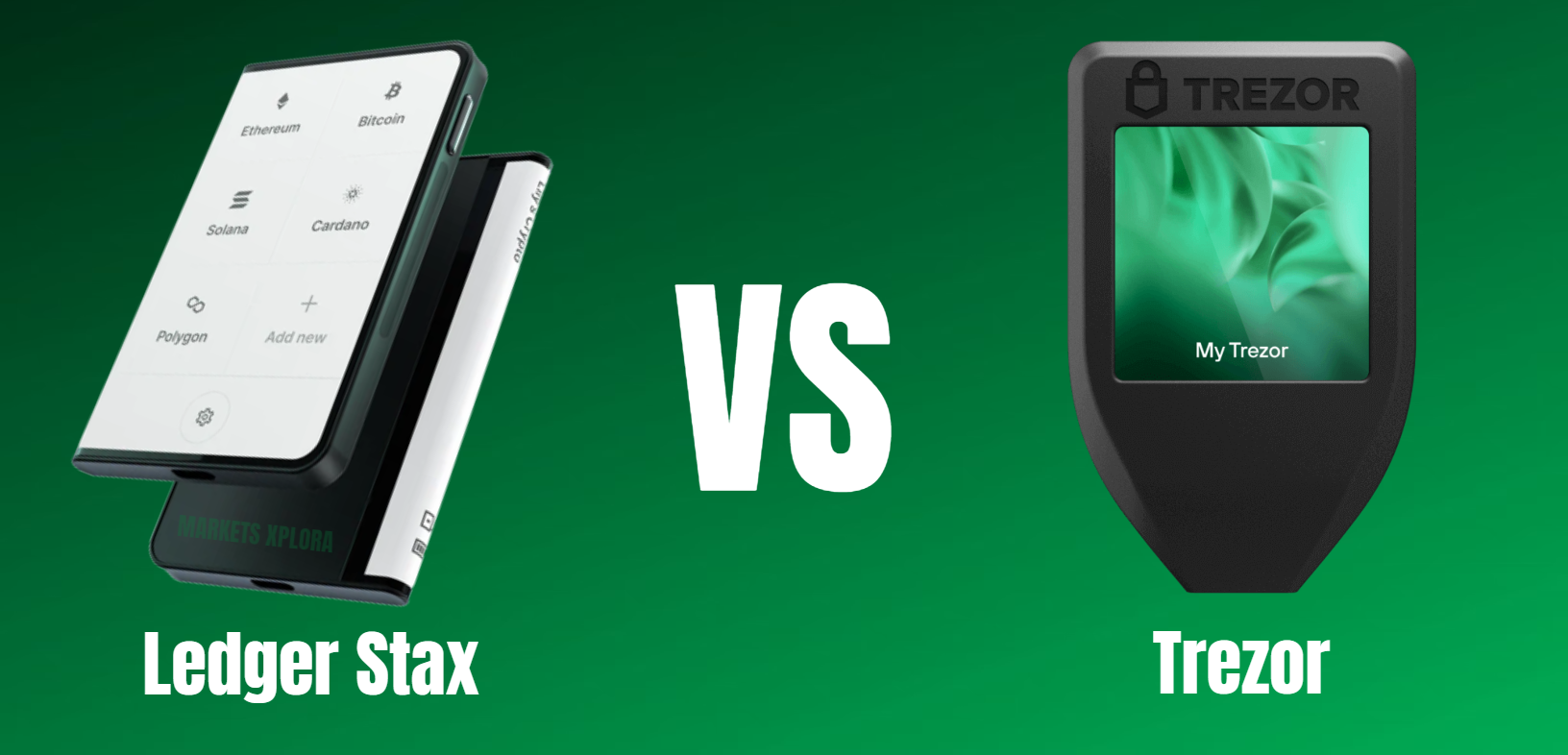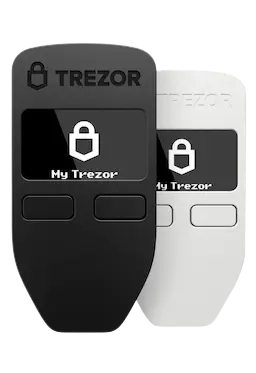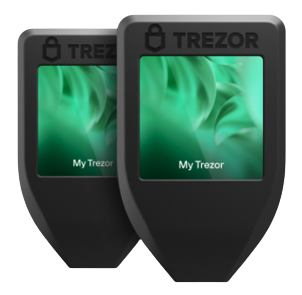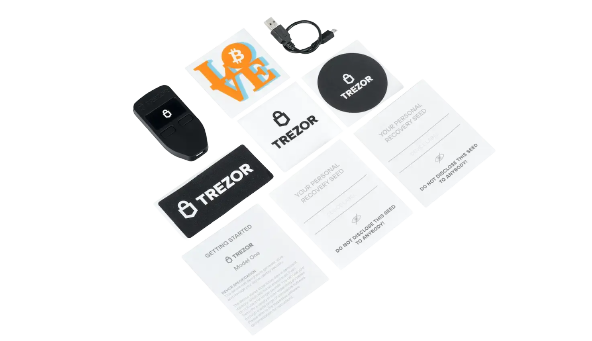
So, you’ve decided to take your crypto security seriously and purchase a hardware wallet.
Congratulations!
In the exciting world of cryptocurrency, securing your digital assets should be of utmost importance.
But now you’re faced with an important decision: Which hardware wallet should you buy?
In this comparison guide, we’ll make it easy for you to decide between two popular hardware wallets in 2023 – Ledger Stax vs Trezor.
Whether you’re a beginner in the world of cryptocurrencies or a seasoned investor, we’ll break down the key factors to consider so you can make an informed decision before buying any of these hardware wallets.
We hope that by the end of reading this guide, you’ll have decided on which one to buy.
Table of Contents
-
- What is a hardware wallet?
- Factors to consider when deciding between Ledger Stax and Trezor
- The companies behind Ledger Stax and Trezor
- A quick Ledger Stax vs Trezor comparison
- Ledger Stax vs Trezor – Pros and cons
- What’s Inside the Box?
- Supported cryptocurrencies
- Technical Specifications
- Display and user experience
- Battery and charging: Who lasts longer?
- Price
- Ready to Decide?
What is a hardware wallet?
Before we delve into the comparison, let’s take a moment to understand what a Bitcoin wallet is and why it’s essential for securing your cryptocurrencies.
A hardware wallet is a physical device designed to store your private keys offline, providing an extra layer of security against online threats.
Unlike software wallets or exchanges, which are connected to the internet, a hardware wallet ensures that your private keys are kept away from potential hacks or cyberattacks.
This makes it an ideal solution for safeguarding your digital assets, especially if you plan to hold onto them for the long term.
Factors to consider when deciding between Ledger Stax and Trezor
Before we delve into the specifics, let’s set the stage by outlining the key factors we’ll be delving into:
- Security Features: The cornerstone of any hardware wallet, from encryption methods to PIN protection.
- Supported Cryptocurrencies: The breadth of coins and tokens that each wallet can handle.
- User Experience: How easy it is to set up, use, and navigate the device.
- Connectivity and Compatibility: The array of available connectivity options and compatibility with various platforms.
- Display Technology: The type of display, its size, and its impact on user experience.
- Battery Life and Charging: The longevity of the battery and the methods for recharging.
- Price and Value for Money: An assessment of the costs in relation to the wallet’s features.
The companies behind Ledger Stax and Trezor
Before we plunge into the specifics, let’s meet the contenders: Ledger Stax and Trezor. Both hail from reputable backgrounds, promising top-tier security and seamless crypto management.
Ledger Stax emerges from the creative hub of Ledger SAS, a French company renowned for its role in the crypto security landscape. With a portfolio of successful hardware wallets like Ledger Nano S and Ledger Nano X, Ledger SAS has laid the groundwork for Ledger Stax’s entrance.
Trezor, on the other hand, is the brainchild of SatoshiLabs, a company dedicated to shaping the crypto world’s future. Founded in 2013, SatoshiLabs has carved its niche by providing robust hardware wallets (Trezor Model One, Trezor Model T, and the latest Trezor Safe 3) and contributing to the crypto community’s security ecosystem.
A quick Ledger Stax vs Trezor comparison
Ready for a head-to-head comparison? Let’s dive right into the arena with a quick overview of the two contenders:
| Aspect | Ledger Stax | Trezor |
|---|---|---|
| Security Features | Secure Element Chip, PIN Protection | Secure Element Chip, PIN Protection |
| Supported Cryptos | 5,000+ | 8,000 (Model One, Model T, and Safe 3) |
| Dimensions | 85mm x 54mm x 6mm | 60x30x6 mm (Model One)
64x39x10 mm (Model T) 59x32x7.4 mm (Safe 3) |
| Weight | 45.2g | 12 g (Model One)
22 g (Model T) 14 g (Safe 3) |
| User Experience | Intuitive touchscreen, customization | Simplified yet efficient interface |
| Connectivity | Bluetooth 5.2®, USB-C | Micro USB connector (Model One)
USB-A to USB-C (Model T) USB-C (Safe 3) |
| Display Technology | Curved E Ink touchscreen | Bright OLED (Model One)
Color LCD touchscreen (Model T) 0.96″ Monochromatic OLED (Safe 3) |
| Battery Life | Built-in rechargeable battery, standby | Long-lasting battery, USB-C charging |
| Price | US$279.00 | US$69.00 (Model One)
US$219.00 (Model T) US$79 (Safe 3) |
Ledger Stax vs Trezor – Pros and cons
Let’s break down the advantages and disadvantages of each wallet, setting the stage for an informed decision:
Ledger Stax Pros and cons
Pros:
- Curved E Ink touchscreen for intuitive interactions.
- Extensive range of supported cryptocurrencies and NFTs.
- Customizable lock screen adds a personal touch.
- Secure Element chip enhances security.
Cons:
- Price – might be expensive for some.

Trezor Model One Pros and cons
Pros:
- Established reputation and a wide user base.
- Robust security features and PIN protection.
- User-friendly interface with two clickable buttons.
- Advanced security features for enhanced protection.
Cons:
- Smaller range of supported cryptocurrencies compared to Ledger Stax.
- Slightly bulkier form factor compared to Ledger Stax.

Trezor Model T pros and cons
Pros:
- Advanced security.
- Features a color touchscreen.
- Caters to a diverse range of crypto portfolios.
- Comes equipped with a microSD card slot.
- Intuitive interface makes the Model T user-friendly, even for beginners in the crypto space.
- Trezor Model T caters to various operating systems, ensuring seamless connectivity.
- Passphrase encryption provides an additional layer of security by allowing you to add an extra phrase to your recovery seed.
Cons:
- Advanced features come at a slightly higher cost.
- Model T may not have as extensive a track record as its predecessor, the Trezor One.

What’s Inside the Box?
The treasure trove within the hardware wallet’s box reveals a lot about the product’s essence.
In the Ledger Stax box, you will find:
- Ledger Stax hardware wallet device
- 1 USB-C to USB-C cable
- 3 recovery sheets
- Ledger Stax guide

Inside the Trezor Model One box, you will typically find the following items:
- Trezor Model One hardware wallet.
- USB cable for connecting the device to your computer or other compatible devices.
- Recovery seed card(s) for securely storing your backup recovery seed.
- Lanyard for attaching the device to your keychain or other accessories.
- Getting Started guide or instructions manual to help you set up and use the hardware wallet effectively.

Trezor’s box contains the following items designed to provide you with everything you need to set up and use your Trezor Model T hardware wallet securely
- Trezor Model T hardware wallet
- USB-C cable (for connecting to devices)
- Magnetic dock (for convenient placement)
- Recovery seed card (for secure recovery)
- Getting Started guide
- Trezor stickers
Supported cryptocurrencies
When it comes to the universe of cryptocurrencies, the ability to handle a broad range is a powerful asset. Ledger Stax supports over 5,000 cryptocurrencies.
From the flagship crypto like Bitcoin and Ethereum to niche players, Ledger Stax covers a lot of ground. But it doesn’t stop there; it extends its reach to Ethereum-based ERC-20 tokens, including NFTs, adding an artistic twist to its portfolio.
Trezor Model One, Model T, and Safe 3 all support around 8,000 cryptocurrencies. This still covers many major coins and tokens, providing you with the essentials. The selection includes Bitcoin, Ethereum, and other well-known players.
- Bitcoin Cash (BCH)
- Bitcoin Gold (BTG)
- Ethereum Classic (ETC)
- Dogecoin (DOGE)
- NEM (XEM)
- Stellar (XLM)
- Ripple (XRP)
- and more…
Technical Specifications
In the realm of hardware wallets, size matters. Ledger Stax arrives with dimensions of 85mm x 54mm x 6mm and a weight of 45.2g. It blends aluminum and plastic seamlessly, creating a modern and robust feel that’s stackable thanks to embedded magnets.
Trezor Model One, on the other hand, boasts dimensions of 60mm x 30mm x 6mm and weighs around 12g. Its compact design is complemented by a durable build.
The dimensions of the Trezor Model T are approximately 64mm x 39mm x 10mm and a weight of 22g.
When it comes to compatibility, Ledger Stax caters to a variety of platforms, including desktop computers (Windows, macOS, Ubuntu), and smartphones (Android, iOS). Trezor Model One and T cover similar ground, providing compatibility with desktops (Windows, macOS, Linux) and a range of mobile devices.
Display and user experience
User experience hinges on display technology. Ledger Stax offers a curved E Ink touchscreen that’s both intuitive and customizable. You can personalize the lock screen, creating a wallet that’s uniquely yours.
Trezor Model One, Model T, and Safe 3 take a simpler route with an OLED display and two buttons.
All three hardware wallets offer ease of use, but the choice comes down to personal preference: a sleek touchscreen or traditional buttons.
Battery and charging: Who lasts longer?
Battery life is another crucial consideration for Ledger Stax vs Trezor. Ledger Stax boasts a rechargeable lithium-ion battery (200 mah) with up to several months of standby time, powered by Qi wireless charging.
Unlike Ledger Stax boasts, the Trezor Model One and T do not have built-in batteries. They are powered by the device it’s connected to via USB. This means that its power source is not limited by its own battery life but by the device it’s connected to. As long as the device you’re connecting it to has power, the Trezor Model One and T can be used.
Price
The price can be a pivotal factor when deciding on which hardware wallet to buy.
- Ledger Stax: The price of Ledger Stax is $279 USD.
- Trezor Model One: The price of Trezor Model One is sold for $69 USD.
- Trezor Model T: The price of Trezor Model T is $219 USD.
- Trezor Safe 3: The price of Trezor Safe 3 is $79 USD.
Your budget and preferred features will drive your decision.
Ready to Decide?
As the dust settles in this battle of the Titans, Ledger Stax vs Trezor, which should you buy?
Choosing between Trezor One and Trezor Model T ultimately boils down to your priorities.
If you’re looking for a cost-effective and reliable Bitcoin hardware wallet with a proven track record, Trezor One might be your choice. However, if you seek an enhanced user experience, broader coin support, and the convenience of a color touchscreen, the Trezor Model T and Ledger Stax offer a compelling upgrade.
Remember, in the world of crypto, security is paramount, and both Ledger Stax and Trezor have your back.
It’s now time for you to assess your priorities, weigh the pros and cons, and make an informed choice that aligns with your crypto investments.
Read also: Where to Buy Ledger Nano X in Nigeria
Tips to secure your Hardware Wallets from hackers
So, you’ve decided to get yourself one of these hardware wallets to keep your cryptos safe from the virtual wolves out there. That’s a smart move! But wait, there’s more to it than just owning one.
Let’s dive into some handy tips to make sure your Ledger Stax and Trezor remains as safe as Fort Knox:
- Buy directly from the manufacturer: When getting your hardware wallet, always purchase it directly from the official manufacturer. This minimizes the risk of receiving a manipulated or compromised device from third-party sellers.
- Use a strong PIN: Your hardware wallet is your digital vault, so choose a strong PIN that’s not easily guessable. Avoid using birthdates or common combinations – go for something that only you would know.
- Keep your recovery phrase offline: This one’s a golden rule. Your recovery phrase is your lifeline. Write it down on a piece of paper and keep it offline, safe from prying eyes and potential hacks.
- Beware of phishing attacks: Hackers are crafty. They might try to trick you into revealing your wallet’s seed phrase through phishing emails or fake websites. Always double-check the URL and never share sensitive info online.
- Firmware updates: Regularly update the firmware of your hardware wallet. Manufacturers often release updates that include security patches and enhancements. Ignoring updates could expose you to vulnerabilities.
- Offline Transactions Are Safer: Whenever possible, initiate transactions while your hardware wallet is offline. This adds an extra layer of security by preventing any online interception of your sensitive information.
- Use Secure Networks: Avoid using public Wi-Fi networks for wallet transactions. Stick to secure, trusted networks to prevent potential data breaches during your crypto dealings.
Following these 7 tips will help ensure that your Ledger Stax and Trezor wallets remains the fortress you need to protect your digital riches.
Ledger Stax vs Trezor: FAQs
1. What’s the main difference between Ledger Stax and Trezor?
Ledger Stax boasts a curved E Ink touchscreen and supports over 5,000 cryptocurrencies, making it a versatile choice for crypto enthusiasts. On the other hand, Trezor comes in three models: the original Trezor One, Model T, and the newer Trezor Safe 3. The Model T sports a color touchscreen and 8,000 supported cryptocurrencies, catering to those seeking an upgraded experience.
2. Which one offers a better user experience?
Both Ledger Stax and Trezor Model T step up the user experience game with their touchscreens. Ledger Stax’s E Ink touchscreen offers an intuitive interface, while the Model T’s color touchscreen enhances navigation and interaction. It’s a win-win for those who appreciate a seamless and user-friendly crypto trading.
3. Are Ledger Stax and Trezor wallets safe?
Absolutely! Both Ledger Stax and Trezor prioritize security. They feature Secure Element chips, PIN protection, and recovery options to ensure your private keys remain locked away from potential hackers. When it comes to security, these wallets mean business.
4. How many cryptocurrencies do they support?
Ledger Stax proudly supports over 5,000 cryptocurrencies, including popular coins and tokens. Trezor Model One and Model T support 8,000 cryptos, while ensuring you have plenty of options for building your crypto portfolio.
That’s a wrap for now, crypto xploras! Remember, there’s no one-size-fits-all answer – the right choice depends on your crypto goals and personal preferences.
